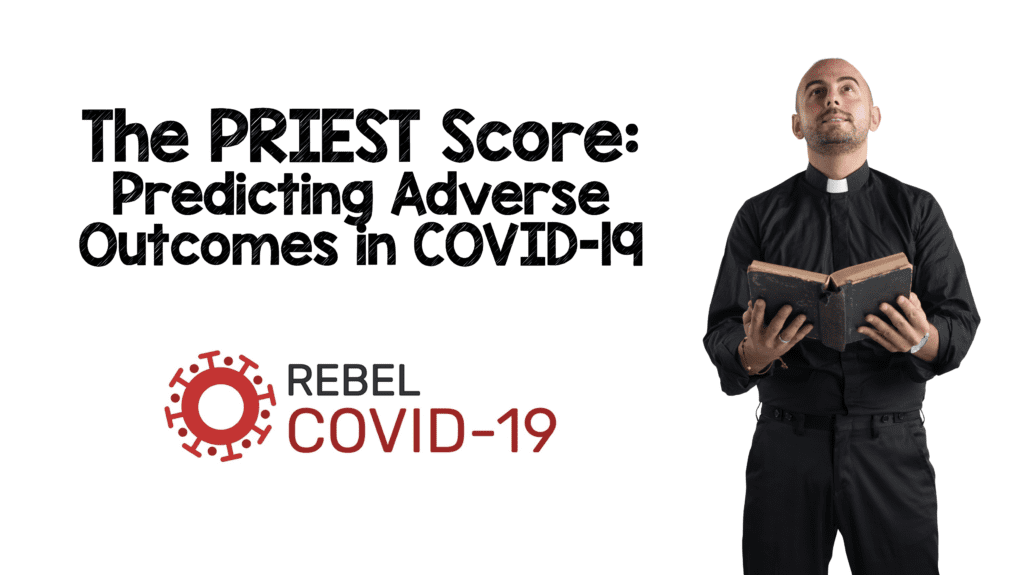
Paper: Goodacre S et al. Derivation and Validation of a Clinical Severity Score for Acutely Ill Adults with Suspected COVID-19: The PRIEST Observational Cohort Study. PLoS One 2021. PMID: 33481930 [Access on READ by QxMD]
Clinical Question: Can the PRIEST score predict adverse outcomes in acutely ill adults with suspected COVID-19 infection?
What They Did:
- Mixed prospective and retrospective observational cohort study in 70 EDs across the UK
- Collected presenting information from 22,445 patients with suspected COVID-19
- Split the cohort into a derivation and validation set:
- Used multivariable analysis to determine variables of the score in the derivation set
- Estimated discriminant performance of the PRIEST score in the validation set
The PRIEST Score (MDCalc):
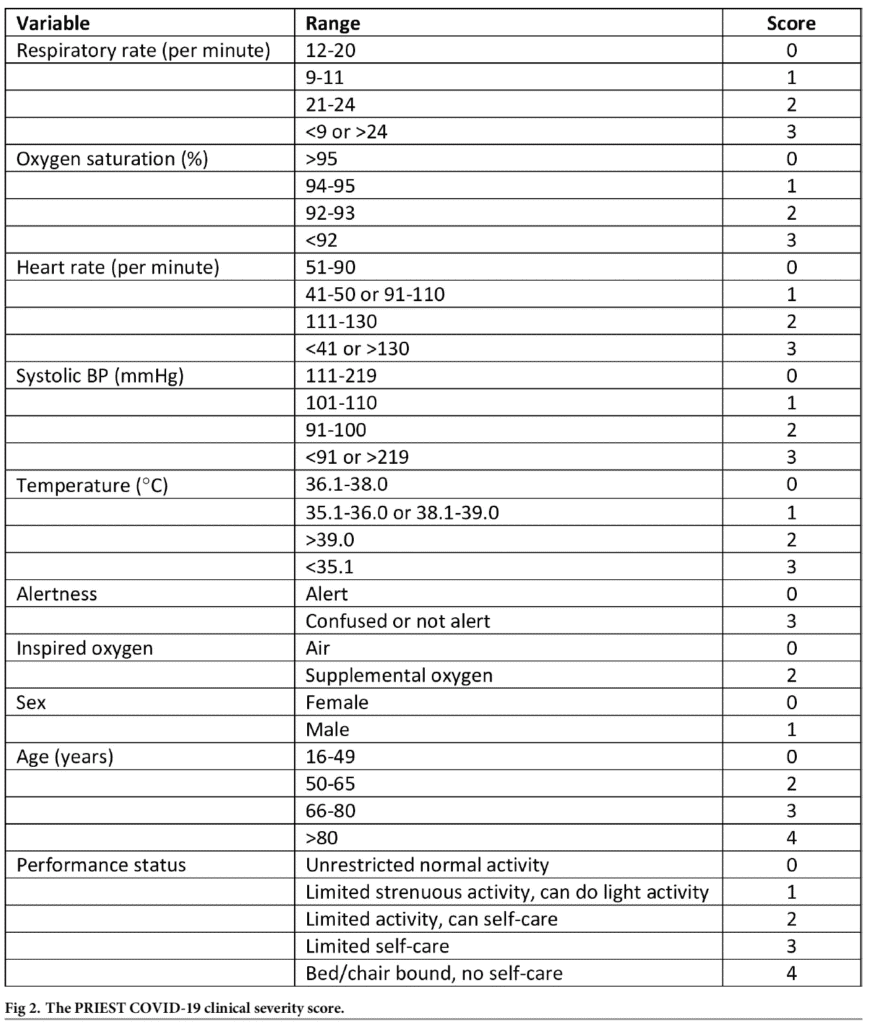
Score ranges from 0 to 29 points (Score >4 predicts adverse outcome with high sensitivity but low specificity)
Outcomes:
- Primary: Death or organ support (respiratory, cardiovascular, or renal) at 30d
- Identify patients at risk of adverse outcome or requiring life-saving intervention to prevent adverse outcome
- Respiratory: Any intervention to protect the airway or assist ventilation (i.e. NIV, CPAP); DID NOT include supplemental O2 alone or nebulized bronchodilators
- Cardiovascular: Any intervention to maintain organ perfusion (i.e. inotropic drugs or invasive monitoring cardiovascular status with CVP or pulmonary artery pressure monitoring, or arterial blood pressure monitoring); DID NOT include peripheral IV cannulation or fluid administration
- Renal: Any intervention to assist renal function (i.e. hemofiltration, HD, or PD); DID NOT include IV fluid administration
- Secondary:
- Death
- Major organ support
Inclusion:
- Meeting clinical diagnostic criteria of:
- Fever (≥37.8C)
- Acute onset of persistent cough (with or without sputum)
- Hoarseness
- Nasal discharge or congestion
- Shortness of breath
- Sore throat
- Wheezing
- Sneezing
Exclusion:
- Age or outcome data missing
Results:
- Enrolled Patients:
- Derivation: 11,773 patients
- Validation: 9,118 patients
- Approximately 31% of each cohort had COVID-19 confirmed
- Univariate Analysis Biggest Predictors of Adverse Outcomes:
- Respiratory rate <9: OR 4.72
- Respiratory rate >24: OR 4.62
- Systolic blood pressure <91: OR 4.17
- Temperature <35.1C: OR 3.97
- GCS 9 – 12: OR 5.32
- GCS ≤8: OR 6.49
- Limited Self Care: OR 4.47
- Bed/Chair bound, no self-care: OR 5.45
- Severe respiratory distress: OR 5.46
- Score based on the NEWS2 score, age, sex, and performance status (see PRIEST score above)
- C-statistic = 0.80 (95% CI 0.79 to 0.81)
- Score >4 predicted adverse outcome:
- Sensitivity 0.98 (95% CI 0.97 to 0.98)
- Specificity 0.34 (95% CI 0.34 to 0.35)
Strengths:
- Score developed to enhance usability:
- Restricted number of variables
- Very few patients with missing data
- Categorized variables in accordance with currently used scores, unless there was clear evidence that these categories provided suboptimal prediction
- Population of patients randomly separated into derivation and validation cohorts by randomly allocating the participating sites to one or the other cohort
- Used three multivariable analyses using different approaches to missing predictor variable data in the derivation cohort
- Calculated diagnostic parameters at each threshold of the score, constructing a receiver-operating characteristic (ROC) curve, calculating the area under the ROC curve (c-statistic) and calculating the proportion with an adverse outcome at each level of the score
- Compared c-statistic with no limitation of predictors and limited number of predictors and found no major difference in simpler score
Limitations:
- Hospital admission and discharge decisions were made according to usual practice, not based on the PRIEST score
- It’s unclear what the inter-rater reliability was on data extractors
- Outcome at 30 days but is that really what we want? We want to know about early deterioration in the ED
- No comparison to gestalt as most of NEWS2 is inherent in our normal evaluation
- Due to COVID-19 testing only being recommended for admitted patients, it was recorded as a descriptive variable, but not used to select patients or in the analysis
- ≈85% of patients included were Anglo with a lack of minorities represented
- Retrospective data collection resulted in some missing data which could result in some inaccuracy of prediction
- Adverse outcome definition did not include all requirements for hospital admission (i.e. IV fluids and oxygen therapy)
- Any score or triage tool should only support and not replace clinical decision-making
Discussion:
- Authors had created the Pandemic Influenza Triage in the Emergency Department (PAINTED) study following the 2009 H1N1 influenza pandemic to develop and evaluate a triage tool for future influenza pandemics. They changed PAINTED to the Pandemic Respiratory Infection Emergency System Triage (PRIEST) study in January 2020 to address any pandemic respiratory infection, including COVID-19
- The PRIEST SCORE:
- Rigorous derivation and validation
- Independently peer-reviewed protocol set up in advance of the pandemic
- Large and representative cohort presenting to EDs
- Analyzed using a pre-specified statistical analysis plan
- The authors put up a nice table to show the sensitivity, specificity, PPV, and NPV at varying cutoffs of the PRIEST score. At my institution we are currently using a cutoff of 5 as opposed to the 4 that was suggested in this study:
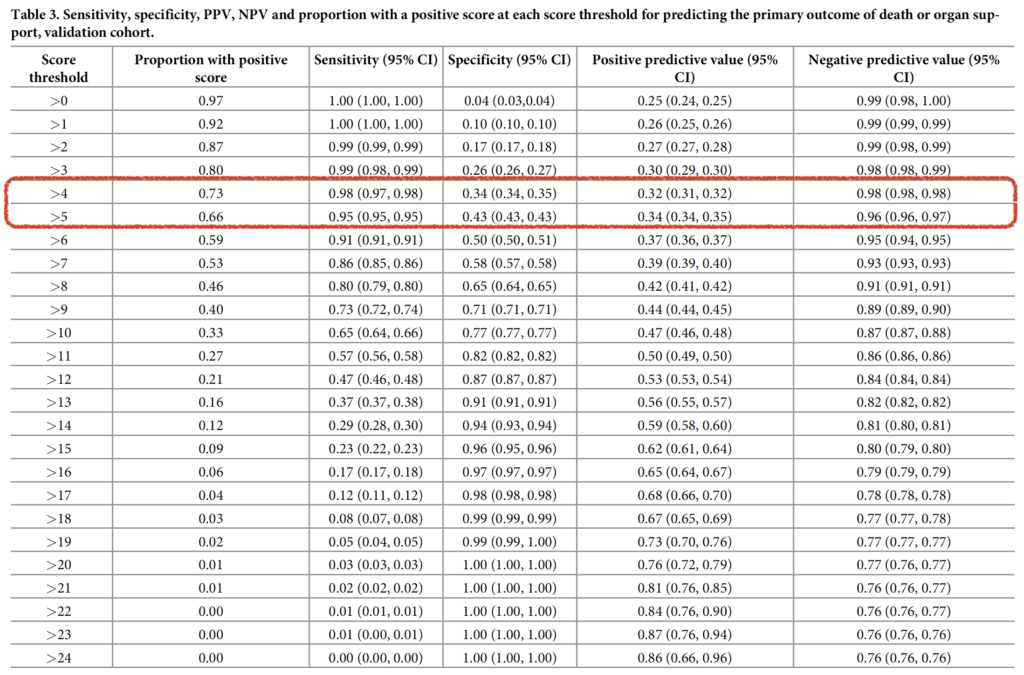
- This was also done for the secondary outcomes of predicting organ support alone and mortality:
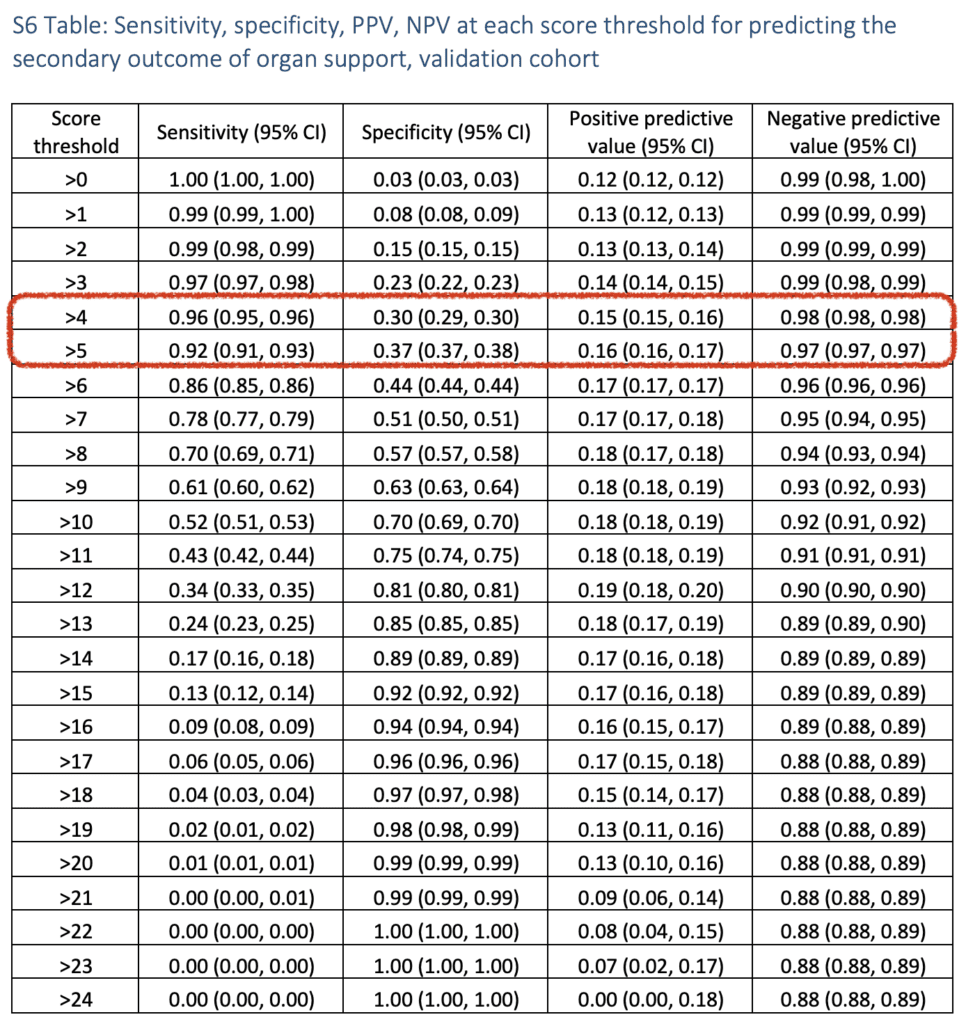
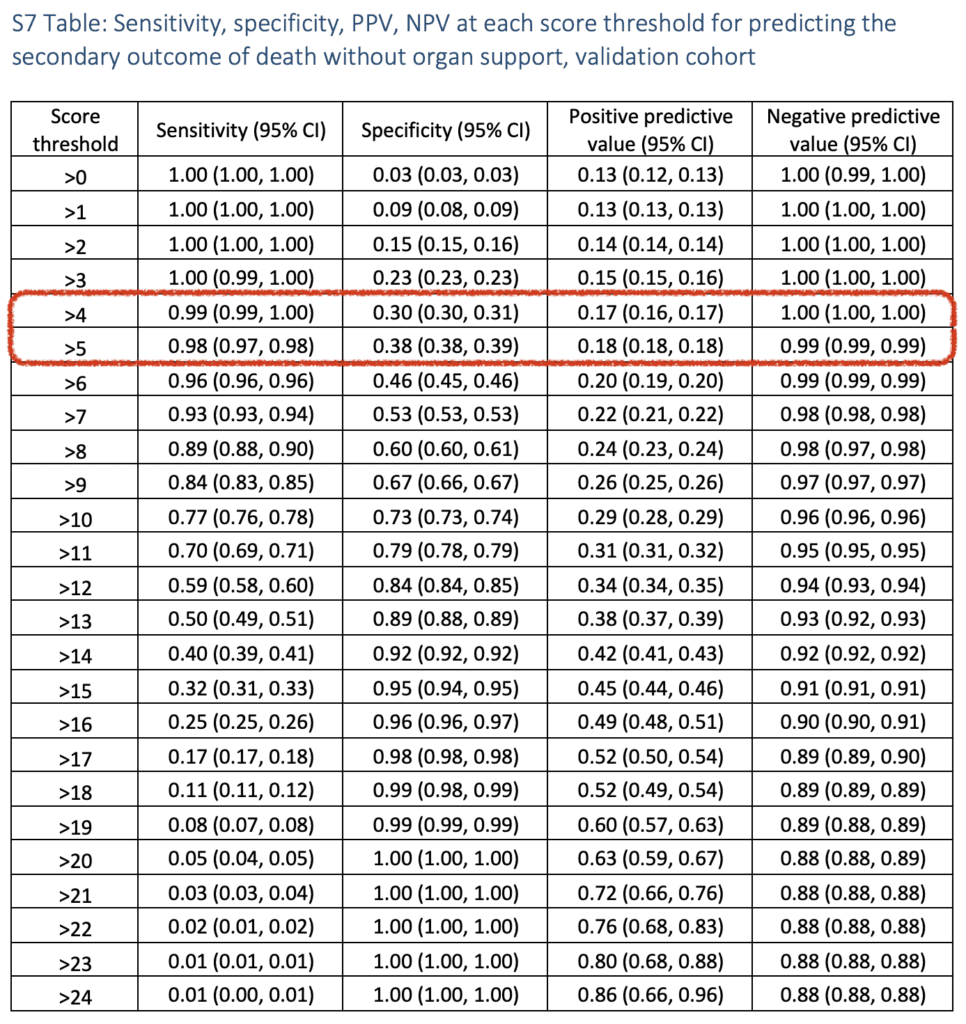
- C-statistic for existing scores used to evaluated acute COVID-19 discussed in the study:
- CURB-65 0.75
- NEWS2 0.77
- PMEWS 0.77
- Limitations of other risk stratification scores:
- Only predict mortality
- Most developed on admitted populations
- Inclusion of laboratory/radiographical variables prolongs ED length of stay and prevents rapid assessment
- Limited by small numbers of patients producing imprecise estimates of accuracy
- Single center design limiting generalizability
Author Conclusion: “A clinical score based on NEWS2, age sex, and performance status predicts adverse outcome with good discrimination in adults with suspected COVID-19 and can be used to support decision-making in emergency care.”
Clinical Take Home Point: The PRIEST score is a rapid assessment tool that can aid in the prediction of adverse outcomes in adults who are acutely ill with suspected COVID-19 presenting to the ED at 30 days. This is promising, however a score that can predict 48-to-72-hour outcomes would be more meaningful.
References:
- Goodacre S et al. Derivation and Validation of a Clinical Severity Score for Acutely Ill Adults with Suspected COVID-19: The PRIEST Observational Cohort Study. PLoS One 2021. PMID: 33481930 [Access on READ by QxMD]
Post Peer Reviewed By: Anand Swaminathan, MD (Twitter: @EMSwami)



